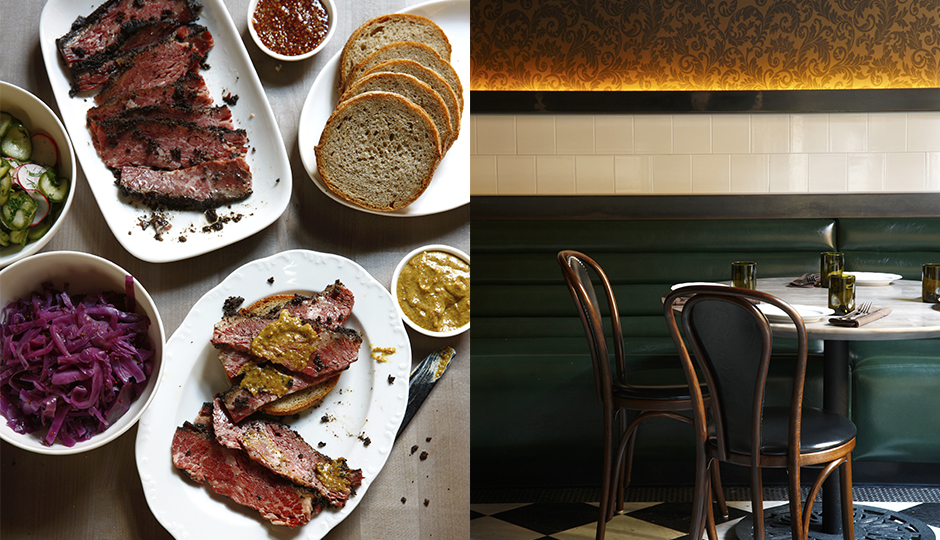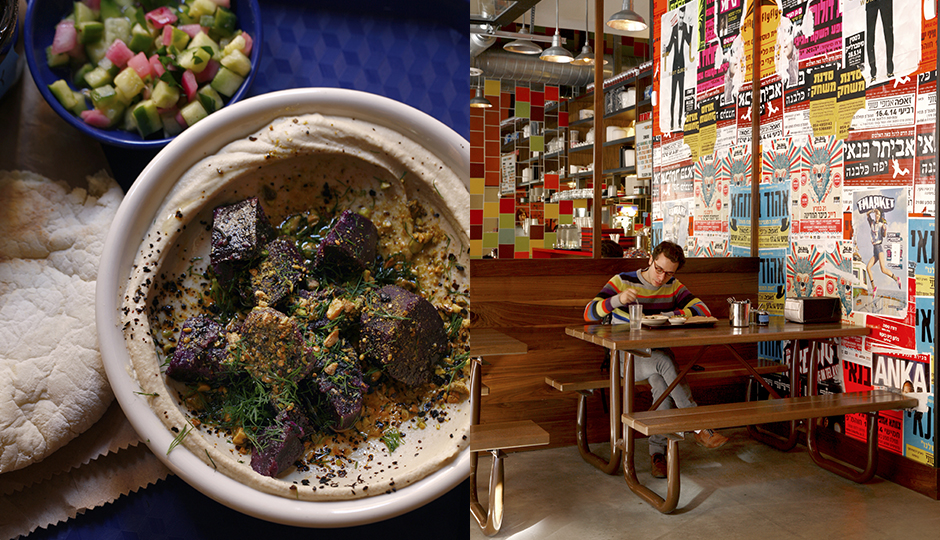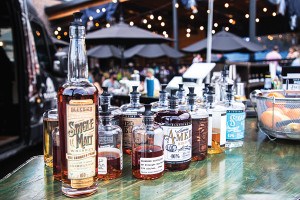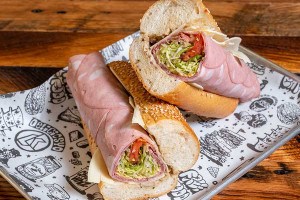Restaurant Review: Abe Fisher and Dizengoff

Abe Fisher | Photos by Jason Varney
On the first evening of Rosh Hashanah this year, BuzzFeed posted a video called “The Jewish Food Taste Test.” In it, Gentiles sample iconic Ashkenazi dishes. Gefilte fish comes first. “It’s like a cold sausage with sour paste on the top,” one goy cringes. “I’m not quite sure what meat it is,” confesses a hoodie-clad Asian dude. A vaguely Nordic-looking hipster delivers the kicker: “It tastes like a grocery store smells.” Suffice it to say that these people were not eating the gefilte fish on offer at Abe Fisher.
Chef Yehuda Sichel, a longtime loyalist of Abe Fisher co-owner Michael Solomonov, stuffs rainbow trout with a delicately nutty forcemeat of striped bass, smoked trout, walnuts and matzo. After poaching the trout whole, he cuts them into what amount to three-inch-thick boneless steaks, crisps the skin, and glazes them with a sweet reduction of carrot juice and port wine. Smoked Hungarian pepper wafts from a slaw of carrot shreds and pickled raisins piled on one side. Underneath it all is a subtly mustardy puree of butter-roasted carrots, accented with horseradish—lest anyone complain that the “sour paste” is missing.
Of all the reasons to celebrate Solomonov and Steve Cook’s return to Jewish cuisine (after three years riding the Federal Donuts juggernaut), a big one is the nature of the complaints people have lodged against Abe Fisher’s gefilte fish. Pungent memories of countless seders have moved so many Jews to dismiss the dish the way my companions did (“This is not gefilte fish”) that the restaurateurs slapped quotation marks around the menu name.
But here’s the thing: This rendition is actually the more authentic one.
“The original gefilte fish was this whole, beautifully stuffed fish,” Solomonov explains. “Not quenelles of shit in a jar of gelatinized carp bones that you only eat on holidays and cover it with horseradish so you can’t taste what you’re eating.”
(You didn’t actually think a bunch of self-amused goyim were going to out-begrudge the grizzled veterans of a hundred jellied-carp Saturdays, did you?)
“European Jewish food doesn’t have a good reputation,” says Solomonov. And Abe Fisher—situated next to his hummusiya, Dizengoff (more on that below), and across the street from one of his Federal Donuts locations—is his attempt to revive it. A checkerboard tile floor and chrome-trimmed bar stools pay homage to the golden age of the Jewish delicatessen. But from the waist up, it’s a brainier affair. Brian Kane has stocked a sexy 10-seat bar with high-concept cocktails. And Sichel is trying to pull off a trick similar to his thrilling redefinition of glatt kosher fine dining when he was the main man at Citron & Rose in Merion Station.
He succeeds twice as often as he fails—which is no small feat when you consider that in some cases, he’s literally working with chopped liver.
That revisionist gefilte fish is a walk-off grand slam.
For a roasted-carrot appetizer, Sichel flips the script. His flash-fried croutons of pumpernickel-and-gouda bread pudding are the stars, and grated six-year-old gouda the intensely aromatic stardust.
Beating expectations for kasha varnishkes may be a short hurdle to clear, but surpassing Sichel’s spin would be a tall one. Say goodbye to clumps of overcooked bowties glued together with buckwheat groats. Abe Fisher—a scrambling of names on Cook’s and Solomonov’s family trees—reimagines this as plump ravioli whose kasha cargo is still assertive enough to shine through a truffle-and-poppy-seed accent.
Reimagination gives way to outright invention when it comes to veal schnitzel. The fried, breaded strips are heaped with deli-style cabbage “health salad,” topped with a squirt of anchovy mayo, and tucked into tortillas; a lemon wedge crusted with Espelette pepper rounds out the most surprising new tacos in town.
I loved all those dishes. Along with a bright “borscht” tartare that pops with trout roe, and Sichel’s idiosyncratic marriage of ultra-crispy brussels sprouts with celery root, almonds, vanilla and calamansi orange, they’d add up to a very compelling meal for two—especially for $39 a person, which buys four courses and unsurpassed hospitality here.
And if you’re rolling with a foursome, go for the Montréal-style smoked short ribs (which are only available in limited quantities each night). An eight-day cure, two hours of smoke and a snail’s-pace roast transform that cut into bright scarlet slices that shimmer like corned beef, smell like smoke and allspice, and feel on your tongue the way rose petals do on your fingertips. Call ahead to check on availability if you have a late reservation. Throw in a loaf of rye and a bowl of sweet Persian cucumber pickles punched up with radishes, and you’ve got a whale of a family meal.
Your biggest worry will be deciding what to drink with it. The prodigiously smoky Bonfire cocktail, which wraps honey and chartreuse in mezcal and Laphroaig? The bittersweet Flatbush Avenue, a boulevardier that swaps out vermouth for barrel-aged Manischewitz? Just beware the Bitter End, a mélange of Campari, Cynar and Cocchi Americano that reads like a dare and tastes like the reductio ad absurdum of the unofficial national contest to see who can concentrate the most bitterness in a single drink.
Abe Fisher opened my mind and taste buds wider than any other restaurant has in a while. It also harbored a few more disappointments. I got Sichel’s playful urge to celebrate Jewish Christmas via shrimp fried rice, but the raw egg yolk on top of his weirdly compressed rice puck was decidedly not an improvement on Chinese-style scrambled curds. A hot-smoked sable cake with Old Bay rémoulade mainly highlighted how much better actual crab is. And if an Ashkenazi place is down with sprinkling bacon bits into a chocolate-foamed egg cream, why not just use crabmeat?
Maybe it comes down to personal preferences, and the fact that mine—like Solomonov’s, for that matter—lie with Sephardic cuisine. So while Abe Fisher’s culinary revivalism has earned my admiration, the hummusiya next door has won my heart.

Dizengoff | Photos by Jason Varney
If only mine weren’t the only one! With a daily capacity of 360 freshly baked pitas and prodigiously tahini-rich, airily whipped hummus that never feels the chill of a refrigerator, Dizengoff was routinely selling out by mid-afternoon within a month of opening.
Credit Zahav alumna Emily Seaman and her crew for changing the way Dizengoff’s fans think about hummus. What used to be the side order on your falafel platter is now a canvas for any number of main attractions. They change so quickly that there’s no use running through a catalog certain to be rendered obsolete by the seasons and Seaman’s self-professed “boredom.”
So let’s just say that she’s a veritable vegetable whisperer, turning whatever produce her farming partners bring through Dizengoff’s garage door into terrifically vibrant creations. A strikingly pale green puree of Kermit eggplants, bristling with sweet-potato chips and fragrant with za’atar, comes to mind. But then, so do two takes on brisket, one heavy on Aleppo pepper and bay leaves, another wearing a mellow perfume of coffee and Yemeni hawaj curry powder and jewel-bright florets of pickled cauliflower. Not to mention the first thing I tried here: pistachio-studded ground lamb. One bite would have filled the cooks at Zahav with pride. Two would have filled them with envy.
Three stars – Excellent
Published in the Decmeber, 2014 issue of Philadelphia magazine


